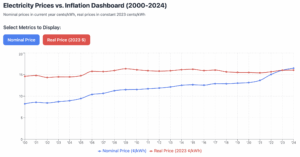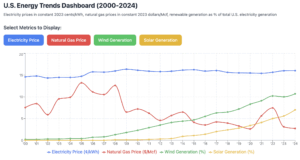After the passage of President Trump’s One Big Beautiful Bill (OBBB), some activists are arguing that the bill will lead to higher electricity prices. This is unlikely, but first, let’s hear the argument. Here’s an overview from Heatmap, a climate-focused newsletter:
The Republican budget reconciliation bill could increase household energy costs by $170 per year by 2035 and $353 per year by 2040, according to a new analysis by Evergreen Action, a climate policy group. “Biden-era provisions, now cut by the GOP spending plan, were making it more affordable for families to install solar panels to lower utility bills,” the report found. The law also cut building energy efficiency credits that had helped Americans reduce their bills by an estimated $1,250 per year. Instead, the One Big Beautiful Bill Act will increase wholesale electricity prices almost 75% by 2035, as well as eliminate 760,000 jobs by the end of the decade. Separately, an analysis by the nonpartisan think tank Center for American Progress found that the OBBBA could increase average electricity costs by $110 per household as soon as next year, and up to $200 annually in some states.
Evergreen Action and others’ claim seems to be that adding more wind and solar to the grid will reduce electricity rates. The reason is simple — unlike natural gas, coal, or nuclear, there is no fuel cost to wind and solar. Therefore, adding electricity generation resources with no fuel cost to the grid should result in lower electricity rates. It’s a nice theory, but does it hold up in the real world?
The real world — electricity rates are pretty stable (and slightly rising since 2019), with growing amounts of wind and solar on the grid
The problem is that we aren’t seeing more wind and solar generation leading to lower electricity rates. In fact, even as wind and solar are generating nearly a fifth of electricity in the United States, rates are up slightly since 2019.
Consider the following chart showing electricity prices over the last 25 years in both nominal prices and prices corrected for inflation:

The biggest takeaway here is simple — over the past 25 years, electricity rates have stayed in a narrow band when you adjust for inflation.
Here is another graphic showing the real price of electricity (the blue line), the price of natural gas (red line), the percentage of total electricity generation from wind (green line), and the percentage of total generation from solar (gold line):

The increase in generation from wind and solar over the past decade is impressive. In 2007, wind and solar produced less than 1% of U.S. electricity generation, growing to produce 18% of generation in 2024. But where are the savings from these sources of generation with no fuel cost? Electricity rates have been very stable (corrected for inflation), but they haven’t gone down. This directly contradicts advocates’ assertion that “cheap” wind and solar will decrease rates. The lack of rate movement is even more curious given that we have seen increasing electricity generation from natural gas, while natural gas prices have steadily fallen for two decades. Those falling natural gas prices should be putting downward pressure on rates.
If adding wind and solar to the grid is going to reduce electricity rates, as the renewable advocates claim, when will we see it in real-world electricity rates? Or is the real world different from the wind and solar activists’ models?
The OBBB’s removal of subsidies for wind and solar won’t happen for years
One glaring problem with the claim that the One Big Beautiful Bill’s removal of subsidies for wind and solar will result in higher electricity prices in the next few years is that it will be years before the subsidies expire. The OBBB terminates the Production Tax Credit (PTC) and Investment Tax Credit (ITC) for wind and solar for facilities that are placed in service after December 31, 2027, and for facilities where construction has not begun before July 4, 2026. And there is even a carveout for projects that begin construction in the next 12 months that could then be eligible for subsidies starting as late as 2030. The Center for American Progress study cited by Heatmap above suggests rate impacts next year, when wind and solar subsidies will still be in effect.
Indeed, because the PTC is paid out over 10 years, wind and solar projects will be receiving the PTC until at least 2037. Even though the OBBB sets an end date for the main wind and solar subsidies, it will be years before they go away, and therefore, years before the removal of these subsidies would have the potential to affect electricity rates.
Activists are making assertions without evidence
In the longer term, the claim that ending wind and solar subsidies would increase electricity rates rests on the assumption that wind and solar generation are “cheap” and that increasing their share would decrease rates. But activists only have model outputs to cite in support of that claim, no actual evidence. The actual observed evidence in the United States, as charted above, contradicts that claim: increasing wind and solar generation have not decreased rates. Indeed, given that natural gas prices have fallen, something in the last ten years is putting increasing pressure on rates that has interfered with that price drop showing up in rates. Observed evidence from other parts of the world offers no more support for the activists’ claims. In Europe, the highest electricity rates are seen in those countries (like Denmark and Germany) with the highest percentages of wind and solar generation.
There is a final logical weakness to activists’ claims. If wind and solar are such cheap and useful sources of electricity, then the elimination of subsidies should not matter. These sources will be built anyway if the activists’ claims are accurate. That activists and the trade associations representing wind and solar developers are so up in arms about the end of the subsidies suggests that they don’t actually believe that these are the cheapest sources of electricity, as they so often claim.
Many factors impact electricity rates. The biggest factor in rates in the next five to ten years is far more likely to be increasing demand, particularly from data centers, than anything in the OBBB. Activists will pounce on any sign of rate increases, but even their post-OBBB forecasts show increasing wind and especially solar generation, which, according to their models, should reduce rates. And this discussion has not even addressed the costs that wind and solar impose on the grid for transmission, balancing, and backup, all of which can be cited as a cause of increasing electricity rates. So take any claims that the OBBB has singularly “caused” electricity bills to go up with a pound of salt.



